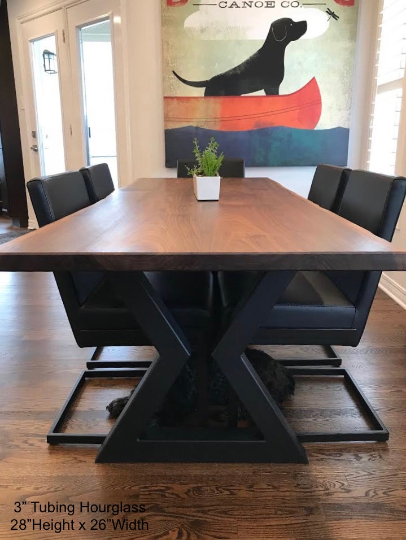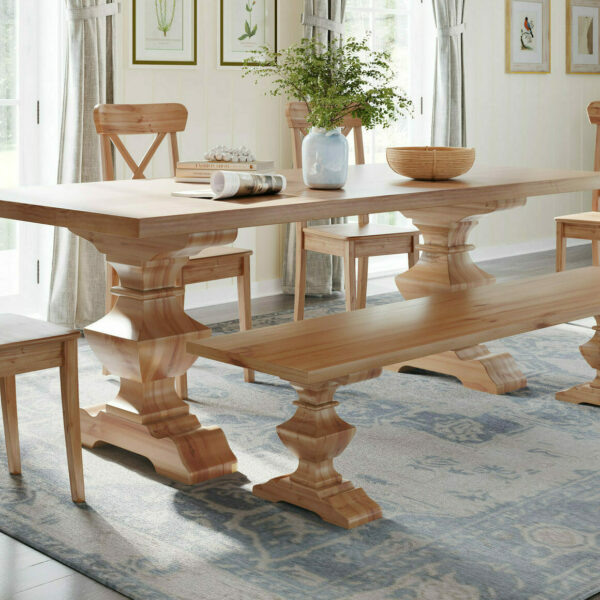Unique Dining Room Table Legs That Will Elevate Your Dining Area
Unique Dining Room Table Legs That Will Elevate Your Dining Area
Blog Article
From Traditional to Modern: Locate the Suitable Eating Space Table Legs for Your Style
While classic styles such as cabriole and transformed legs evoke a sense of ageless refinement, contemporary styles like barrette and geometric alternatives present a chance for striking aesthetic passion. As you consider these aspects, the inquiry continues to be: how can you perfectly incorporate these varied leg designs to create a harmonious dining experience?
Comprehending Table Leg Styles
The range of dining-room table leg designs can substantially affect both the aesthetics and functionality of the space. Each leg style adds one-of-a-kind sensible attributes and visual aspects, catering to diverse design choices and use demands. Comprehending these styles is essential for selecting the right table that lines up with your total interior decoration vision.
As an example, tapered legs use a tidy, classic look that can enhance a room's elegance, while pedestal bases give stability and make the most of legroom, making them ideal for smaller sized spaces. Barrette legs, a characteristic of mid-century contemporary design, present a commercial flair, enabling a ventilated, open feel. Similarly, trestle legs stimulate rustic charm, providing durable support and a feeling of timelessness.
In addition, the option of materials plays a substantial function. Wood legs can bring warmth and appearance, whereas metal alternatives commonly convey a streamlined, contemporary ambiance. Ultimately, recognizing table leg styles is necessary for creating a natural dining location that mirrors personal design while ensuring functionality and comfort. By thoughtfully taking into consideration these aspects, you can boost both the visual and functional charm of your eating space.
Traditional Table Leg Options
When choosing dining-room table legs, traditional choices commonly personify timeless beauty and workmanship. These layouts mirror an abundant heritage and a dedication to quality, making them perfect for those who value traditional appearances.
One of the most iconic conventional leg styles is the cabriole leg, defined by its stylish rounded shape. This style commonly includes ornamental makings and is most frequently located in Queen Anne and Chippendale furnishings. One more prominent choice is the turned leg, which boasts a series of smooth, rounded shapes that provide a classic appearance while keeping security.
In addition, the straight leg, while straightforward, supplies a durable and unadorned structure that can mix flawlessly with a selection of tabletop styles. For those drawn to ornate detailing, claw-and-ball feet legs stimulate a feeling of magnificence and can serve as a spectacular prime focus in any kind of eating area.
Lastly, stand bases, although not strictly legs, provide a different traditional option that enables adequate legroom and can be beautifully sculpted. Each of these standard leg designs contributes to the general setting of an eating space, weding feature with aesthetic allure.

Modern Table Leg Styles
Modern table leg layouts use a diverse series of styles that stress cutting-edge products and tidy lines. These designs usually prioritize functionality while serving as striking centerpieces within a dining room. Minimalist appearances prevail, with legs crafted from products such as metal, glass, and crafted timber, which contribute to a contemporary and ventilated feel.
One prominent layout is the hairpin leg, defined by its slim, tapered framework that gives stability without frustrating the table top (dining room table legs). This style is commonly found in mid-century contemporary furnishings and can easily complement different eating table forms. Another pattern is using geometric forms, where legs may handle asymmetrical or angular forms, adding aesthetic passion and a touch of artistry

Mixing Designs for One-of-a-kind Rooms
Usually, home owners look for to produce distinct dining spaces that mirror their individual style by blending various layout components. This technique enables for the incorporation of diverse aesthetics, causing an unified yet unique environment. Matching a rustic wooden table with streamlined, contemporary metal legs can produce visit this page an appealing contrast that raises the room's total charm.
Additionally, incorporating vintage table legs with contemporary table tops can evoke a feeling of history while keeping a contemporary perceptiveness. Such combinations not just showcase specific taste yet likewise urge imagination, permitting house owners to curate a space that feels both individual and inviting.
Shade plays an important duty in this mixing procedure; choosing table legs that match or contrast with the existing color design can enhance visual passion. Whitewashed legs can soften the look at here daring of a dark table surface area, producing a well balanced visual.
Tips for Choosing the Right Legs
Picking the right table legs is important for attaining both functionality and aesthetic charm in your dining room. Begin by considering the general design of your area. Conventional setups profit from legs that include elaborate carvings or transformed layouts, while contemporary spaces may require streamlined, minimal styles.
Next, examine the elevation and security of the legs. dining room table legs. Standard dining tables range in between 28 to 30 inches in elevation, so make certain the legs complement this measurement for comfort. Furthermore, robust materials, such as hardwood or steel, can improve security and long life
Review the leg form too-- options include straight, tapered, or pedestal designs. Straight legs offer a classic look, while tapered legs can add a touch of beauty. Pedestal bases offer adequate legroom and are suitable for smaller sized areas.
Final Thought
In recap, choosing the suitable dining-room table legs needs cautious consideration of both modern and traditional designs. Standard choices such as cabriole and turned legs provide timeless elegance, while contemporary designs like hairpin and geometric shapes give a contemporary touch. By harmonizing leg style, height, and product with the total décor, a Continue natural and welcoming atmosphere can be accomplished. Ultimately, the chosen table legs need to reflect the desired aesthetic, enhancing the eating experience within the area.
The range of eating room table leg styles can considerably affect both the visual appeals and performance of the space. Eventually, comprehending table leg designs is crucial for developing a cohesive eating area that reflects personal design while ensuring practicality and convenience.One of the most renowned traditional leg styles is the cabriole leg, identified by its stylish curved shape. Straight legs offer a traditional appearance, while conical legs can include a touch of elegance.In recap, choosing the optimal dining space table legs requires careful consideration of both contemporary and standard designs.
Report this page